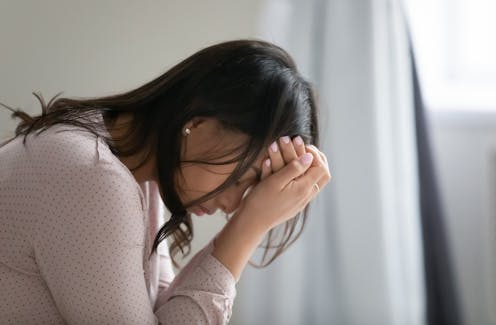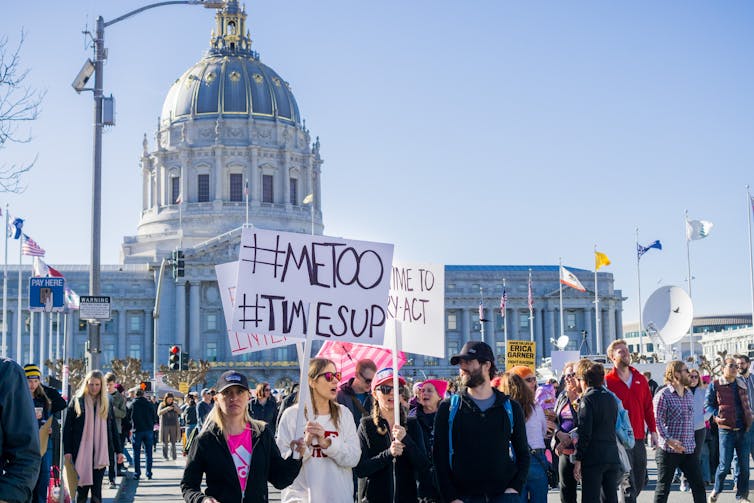
When writer E. Jean Carroll was asked why she finally went public – after more than 25 years – to accuse then US president Donald Trump of sexual assault, her response was something that countless others have thought: “Think of how many women have come forward and nothing happens.”
The thousands of comments on a YouTube clip of that interview show the typical backlash faced by people who come forward with such accusations. They are cruel and misogynistic, unsubstantiated accusations that the person is crazy, attention-seeking, a money grabber, a liar and not a “real” victim.
Commenters claim to know how a “real” victim reacts – they scream, tell someone right away or go to the police. They do not keep quiet for years.
Unlike Carroll, most victims will not have the resources to pursue their abusers in court. Rarer still is that perpetrators are found liable, as Trump was for sexual abuse and defamation.
But what all women who accuse high-profile men of sexual abuse have in common, is their experience with the vitriol, myths and misconceptions that stop so many others from speaking out. This is already being seen in the public reaction to the allegations against comedian Russell Brand, though it must be remembered that the allegations have not yet been tested in any court.
According to the Rape, Abuse & Incest National Network in the US, only about 30% of sexual assaults are reported to police. Of those, fewer than 3% of cases lead to a conviction. Similar statistics are found in the UK.
There is little chance for due process, but a huge risk of reliving deeply traumatising experiences while being doubted, undermined, and in high profile cases, publicly shamed.
Most perpetrators also have a relationship with their victims. This is usually an unbalanced power dynamic, such as a work supervisor or romantic partner. In these cases, the consequences of reporting can also threaten someone’s career, family and personal life.
Myths about assault survivors
There are a number of false beliefs used against victims (also called survivors) at every turn. The most common myths include that the victim is lying or secretly “wanted it”, the perpetrator didn’t mean to, it wasn’t that bad, a “legitimate” victim would’ve fought back and the victim is seeking attention.
These myths perpetuate gendered stereotypes – that women who experience violence are helpless or promiscuous – and often ignore the experiences of male and LGBTQ+ victims.
Such ideas are not just the purview of online mobs, they are enmeshed in the structures that are meant to protect victims. They are repeated in police reports, are a defence tactic in court and used in workplaces to protect perpetrators.
They are used in news coverage of high-profile cases. But even when a case is not making international news, they are repeated in families, in social circles, at work and in religious settings.
It is no wonder then, that most people who experience sexual violence never report to police or go public. They doubt themselves, feel shame and lack trust in institutions to help.
The low conviction rate and problematic cultural attitudes – as displayed in reactions to high-profile accusations – reaffirm their fears and keeps reporting low.
What does it take to come forward?
Research shows people are more likely to come forward when they trust institutions like their university or workplace.
Other factors that can encourage reporting include receiving institutional training on how to report and access to victim advocates, who are starting to be hired by some law enforcement.
Social media, despite being a hub of toxicity, can also be a place to encourage people to speak out. Once one person comes forward, others will follow.

It can take years for allegations against a powerful person to come to light. Timing can also determine public reactions. When not at their peak power, the accused are often more likely to face consequences. Trump losing the civil suit after he was president seemed to produce less backlash than when Carroll first came forward.
But when a US Supreme Court seat was in the balance, Christine Blasey Ford received death threats and had to move to protect herself and her family after accusing Brett Kavanaugh of a historic sexual assault.
Blasey Ford described how the support of family, friends, the journalists she trusted and many in the public gave her the strength when she came forward. Yet, they couldn’t protect her from the retaliation that totally disrupted her life.
A changing culture
A common excuse for not believing sexual violence allegations is that there’s not enough proof – it’s her words against his. But for those who perpetuate rape myths, gathering evidence doesn’t seem to matter.
After every serious journalism report, like The Times, Sunday Times and Channel 4 investigation into Russell Brand, is an avalanche of celebrities and fans defending the accused and denigrating the accuser.
This is meant to be the post-#MeToo era, where it’s possible for people to speak out and be listened to, and to have their allegations taken seriously and investigated by the authorities. Serial abusers like former Hollywood producer Harvey Weinstein, former doctor to the US women’s national gymnastics team Larry Nassar and singer R. Kelly are serving decades-long prison sentences.
These cases may bring some sense of justice for the victims who faced public exposure, personal anxiety and the re-traumatisation that comes with telling and retelling their experiences.
Despite this, the persistence of rape myths is still making it difficult for people to come forward. It may take many more years of historic allegations coming to light before we see the much needed cultural change and reform to the systems that still fail victims.
Lindsey Blumell has received funding from City, University of London to conduct her research.
This article was originally published on The Conversation. Read the original article.







